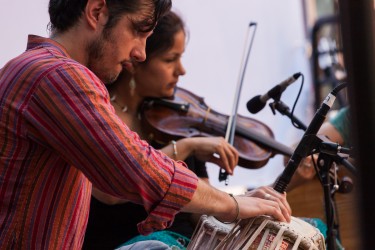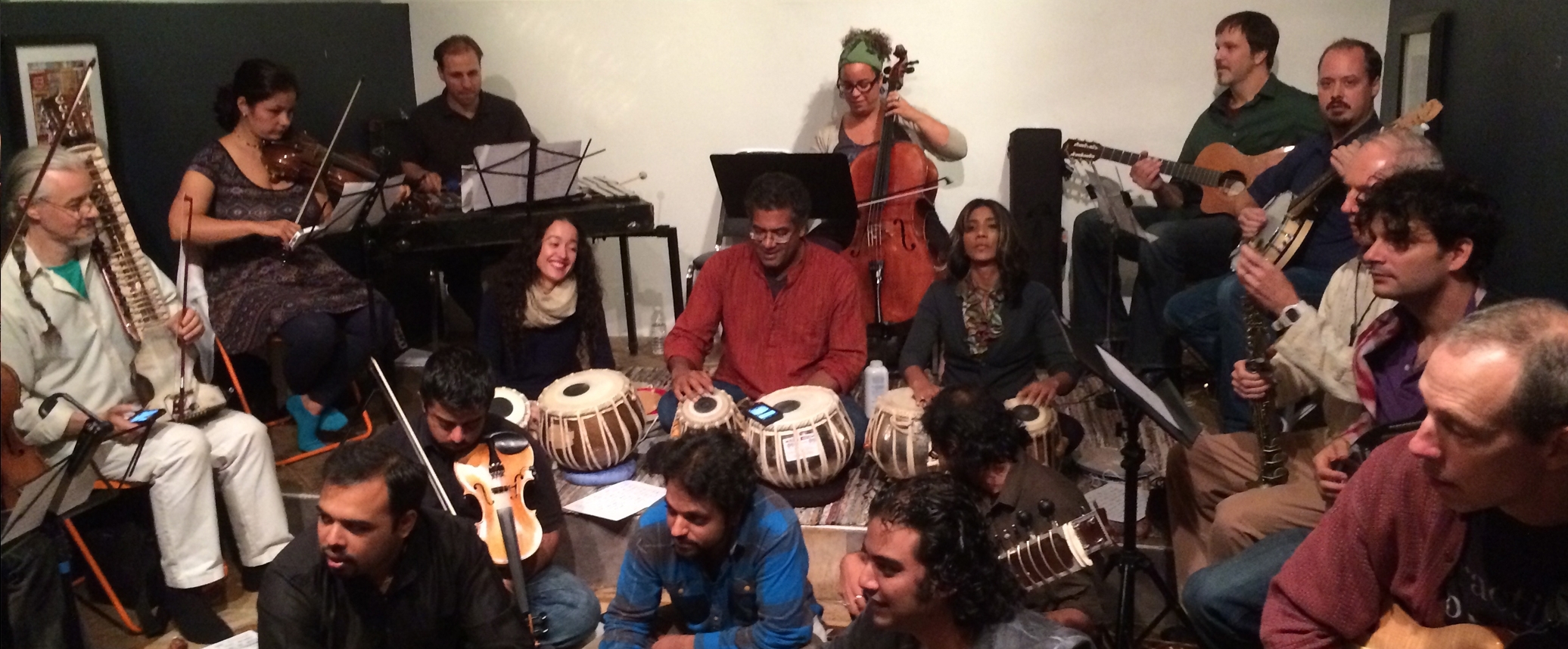
An interview with David Ellenbogen
Brooklyn Raga Massive, now a globally recognized musician’s collective, is made up of world class, forward thinking musicians rooted in Indian classical music. After a rousing performance at our recent Block Party, Brooklyn Raga Massive will return to the Rubin for two special shows. On August 12, they will bring their well-known Wednesday Night Jam session to the Museum, and on August 28, the BRM All Stars will perform the piece credited with creating minimalism: Terry Riley’s composition “In C”.
We caught up with musician, producer, and radio host David Ellenbogen of Brooklyn Raga Massive to tell us about raga’s mass appeal, what Indian classical music has in common with Philip Glass and yoga, and why the group can’t seem to get enough of the Rubin.
How would you describe Brooklyn Raga Massive and your influences?
Brooklyn Raga Massive is an artist’s collective of musicians who are inspired by and dedicated to the Indian classical tradition. There is something magical happening right now. There is a new generation of musicians who are disciples of some of the greatest living Indian Classical musicians, but who also speak the languages of jazz, funk, reggae—not as outsiders, but as insiders of both traditions. Sameer Gupta is a great example of this, touring relentlessly with jazz icon Marc Cary but also deeply studying with one of the greatest tabla players in the world, Anindo Chatterjee. To me, Brooklyn Raga Massive is providing a platform and home for this kind of germination of new styles and languages. It’s also finding new audiences for traditional classical music by keeping the atmosphere festive and fun. At our weekly jam sessions we have new styles emerging, there are Africa/India nights, chamber raga groups and much more. People in India are paying attention to what’s happening in Brooklyn and the term “raga renaissance” has floated around the press there.
I am amongst the members who are not as steeped in that classical tradition, but I find endless inspiration and beauty in it. My background as a musician is to study the music wherever I travel, and luckily that has been in India, Mali, Ghana, Brazil and a few other spots. I also play Western styles from Bach to Stevie Wonder. Generally when I join the BRM on stage, I’m introducing a groove element. For example, I can’t imagine anything prettier than the sound of an Afro-Brazilian Bahiana with, say, an Indian, bansuri flute.

For those who have never heard it before, how would you describe raga music?
Literally, they say raga means “to color the mind.” The music is very subtle and precise in order to capture a specific mood to match a specific time of day. There are evening ragas (which may be more romantic) and morning ragas (which may be more energizing or devotional) and so on. It harmonizes you. The pieces begin by slowly introducing each note with a reverence and respect for sound and place that is almost the antithesis of our modern lifestyle. By the end, the music is an explosion of virtuosity and intensity. It’s a journey and much like with yoga, you feel better afterwards.
Who might like traditional raga that you wouldn’t necessarily expect?
I know two people who are both into something called death metal as well as Indian raga!
Tell us about Terry Riley’s “In C” and your decision to perform it. What can people expect at that concert?
Terry Riley’s “In C” is an amazing piece and is often credited for creating the style of music called minimalism, which is associated with Philip Glass and Steve Reich. The piece has forty cells of music, short phrases, which are played progressively by the musicians at any time as long as they stay within three or four of the rest of the group. They can come in anywhere on the beat, or multiply or divide the rhythm as they see musically fit”¦.What this creates is a harmonious sea of music, with moments of amazing beauty. The experience could be considered psychedelic, I suppose”¦especially when combined with psychedelics! It makes a lot of sense to have Indian instruments performing this as Riley was very influenced by raga and studied it quite deeply. However, he has told us that as far as he knows, Brooklyn Raga Massive is the first group of its kind to perform this piece. He responded positively to a clip we sent him and encouraged us to improvise more. It meant a lot to us to get his feedback, and recently we have been approached by a record label we’re fans of that wants to release our version.
You’ve had a history of playing at the Rubin Museum (most recently at our Block Party) ““ is there anything in particular that you like about performing here? What makes it a special place?
Performing at the Rubin is a dream come true for us because there is no other cultural institution in NYC so focused on the same ideals. At its best this style of music takes you to the Himalayas—the Rubin certainly does that. In future collaborations we hope to engage more directly and specifically with the artwork: like facets of a diamond, there are a million symphonies in every mandala.
Brooklyn Raga Massive will perform at the Rubin for a special show and jam session on August 12 and an interpretation of “In C” on August 28.
David Ellenbogen is a musician, producer and radio host. His most recent production was last month’s Ragas Live Festival, a 24 hour radio broadcast of Indian Raga, in which over eighty world-class musicians performed live in the studio. You can hear the entire festival and much more at his podcast NYC Radio Live. David will also appear as our guest DJ in the K2 Lounge on August 14.

